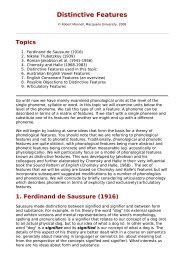Festival Speech Synthesis System: - Speech Resource Pages
Festival Speech Synthesis System: - Speech Resource Pages
Festival Speech Synthesis System: - Speech Resource Pages
Create successful ePaper yourself
Turn your PDF publications into a flip-book with our unique Google optimized e-Paper software.
no exchange takes place.<br />
Daughters of a node are actually represented as a list whose first daughter is double linked to the parent. Although<br />
being aware of this structure may be useful it is recommended that all access go through the tree specific functions<br />
*.parent and *.daughter* which properly deal with the structure, thus is the internal structure ever changes in<br />
the future only these tree access function need be updated.<br />
With the above functions quite elaborate utterance manipulations can be performed. For example in post-lexical rules<br />
where modifications to the segments are required based on the words and their context. See section 13.8 Post-lexical<br />
rules, for an example of using various utterance access functions.<br />
[ < ] [ > ] [ > ] [Top] [Contents] [Index] [ ? ]<br />
14.6 Features<br />
In previous versions items had a number of predefined features. This is no longer the case and all features are<br />
optional. Particularly the start and end features are no longer fixed, though those names are still used in the<br />
relations where yjeu are appropriate. Specific functions are provided for the name feature but they are just short hand<br />
for normal feature access. Simple features directly access the features in the underlying EST_Feature class in an<br />
item.<br />
In addition to simple features there is a mechanism for relating functions to names, thus accessing a feature may<br />
actually call a function. For example the features num_syls is defined as a feature function which will count the<br />
number of syllables in the given word, rather than simple access a pre-existing feature. Feature functions are usually<br />
dependent on the particular realtion the item is in, e.g. some feature functions are only appropriate for items in the<br />
Word relation, or only appropriate for those in the IntEvent relation.<br />
The third aspect of feature names is a path component. These are parts of the name (preceding in .) that indicated<br />
some trversal of the utterance structure. For example the features name will access the name feature on the given<br />
item. The feature n.name will return the name feature on the next item (in that item's relation). A number of basic<br />
direction operators are defined.<br />
n.<br />
next<br />
p.<br />
previous<br />
nn.<br />
next next<br />
pp.<br />
previous<br />
parent.<br />
daughter1.<br />
first daughter<br />
daughter2.<br />
second daughter<br />
daughtern.<br />
last daughter<br />
first.<br />
most previous item<br />
last.<br />
most next item<br />
Also you may specific traversal to another relation relation, though the R:. operator. For<br />
example given an Item in the syllable relation R:SylStructure.parent.name would give the name of word<br />
the syllable is in.<br />
Some more complex examples are as follows, assuming we are starting form an item in the Syllable relation.
















